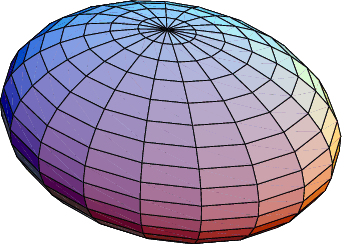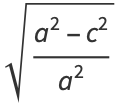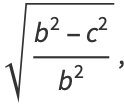
The general ellipsoid, also called a triaxial ellipsoid, is a quadratic surface which is given in Cartesian coordinates by
(1)
|
where the semi-axes are of lengths  ,
,  , and
, and  . In spherical coordinates, this becomes
. In spherical coordinates, this becomes
(2)
|
If the lengths of two axes of an ellipsoid are the same, the figure is called a spheroid (depending on whether  or
or  , an oblate spheroid or prolate spheroid, respectively), and if all three are the same, it is a sphere. Tietze (1965, p. 28) calls the general ellipsoid a "triaxial ellipsoid."
, an oblate spheroid or prolate spheroid, respectively), and if all three are the same, it is a sphere. Tietze (1965, p. 28) calls the general ellipsoid a "triaxial ellipsoid."
There are two families of parallel circular cross sections in every ellipsoid. However, the two coincide for spheroids(Hilbert and Cohn-Vossen 1999, pp. 17-19). If the two sets of circles are fastened together by suitably chosen slits so that they are free to rotate without sliding, the model is movable. Furthermore, the disks can always be moved into the shape of a sphere (Hilbert and Cohn-Vossen 1999, p. 18).
In 1882, Staude discovered a "thread" construction for an ellipsoid analogous to the taut pencil and string construction of the ellipse (Hilbert and Cohn-Vossen 1999, pp. 19-22). This construction makes use of a fixed framework consisting of an ellipse and a hyperbola.
(3)
| |||
(4)
| |||
(5)
|
for  and
and ![v in [0,pi]](http://mathworld.wolfram.com/images/equations/Ellipsoid/Inline16.gif) .
.
In this parametrization, the coefficients of the first fundamental form are
(6)
| |||
(7)
| |||
(8)
|
and of the second fundamental form are
 |
(9)
| ||
(10)
| |||
(11)
|
Also in this parametrization, the Gaussian curvature is
(12)
|
and the mean curvature is
(13)
|
The Gaussian curvature can be given implicitly by
(14)
| |||
(15)
| |||
(16)
|
The surface area of an ellipsoid is given by
(17)
| |||
![2pi[c^2+(bc^2)/(sqrt(a^2-c^2))theta+bsqrt(a^2-c^2)E(am(theta),k)],](http://mathworld.wolfram.com/images/equations/Ellipsoid/Inline49.gif) |
(18)
|
where  ,
,  , and
, and  are Jacobi elliptic functions with modulus
are Jacobi elliptic functions with modulus  ,
,
(19)
| |||
 |
(20)
| ||
 |
(21)
|
(22)
|
where  is another Jacobi elliptic function with modulus
is another Jacobi elliptic function with modulus  (Bowman 1961, pp. 31-32; error corrected).
(Bowman 1961, pp. 31-32; error corrected).
Another form of the surface area equation is
![S=2pi[c^2+(bc^2)/(sqrt(a^2-c^2))F(phi,k)+bsqrt(a^2-c^2)E(phi,k)],](http://mathworld.wolfram.com/images/equations/Ellipsoid/NumberedEquation6.gif) |
(23)
|
where
 |
(24)
|
The surface area can also be obtained directly from the first fundamental form as
(25)
| |||
(26)
| |||
 |
(27)
|
The volume of an ellipsoid is
(28)
|
The geometric centroids of the half-ellipsoids along the  -,
-,  -, and
-, and  -axes are
-axes are
(29)
| |||
(30)
| |||
(31)
|
The moment of inertia tensor of an ellipsoid is given by
![I=[1/5M(b^2+c^2) 0 0; 0 1/5M(a^2+c^2) 0; 0 0 1/5M(a^2+b^2)].](http://mathworld.wolfram.com/images/equations/Ellipsoid/NumberedEquation9.gif) |
(32)
|
A different parameterization of the ellipsoid is the so-called stereographic ellipsoid, given by the parametric equations